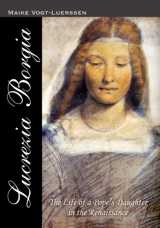
Maike Vogt-Luerssen
Lucrezia Borgia – The Life of a Pope's Daughter in der Renaissance
124 pages, with family trees and 76 figures
ISBN 978-1-4537-2740-9
1st English edition 2010
US$ 10.90
This book is available through www.amazon.com
as E-Book:
with family trees and 78 figures (of which 37 are in colour)
published in 2014
available as E-Book everywhere in the world at amazon for example
at www.amazon.com for US$ 10.86
at www.amazon.co.uk for £ 7.20
This biography will reveal the true Lucrezia Borgia. It is an unfortunate reality that many descriptions of the life of the Pope's daughter and her family are based on malicious rumours by her opponents and sensationalist historians of the 16th century. Even the 19th century biographer Ferdinand Gregorovius would often accept these as gospel. Yet there are many contemporaries of the Borgias, whose notes and letters we should give more credence to than to those of their enemies or certain authors who only knew the Borgias from hearsay. Especially invaluable is the diary of Johann Burchard, the Master of Ceremonies of the popes. He kept detailed records of all the important events from 1483 until he died in 1506. His dispassionate and factual descriptions of the occurrences at the papal court defy many claims about the Borgias. In addition, countless letters and documents of Lucrezia herself and her relatives have survived. They depict her as a typical woman of her times, yet also as a truly remarkable individual. For wherever it involves the Borgia family, you can rest assured that the truth will be no less suspenseful than even the wildest rumours.
Preface
This book will acquaint you with the life of Lucrezia Borgia, one of the most significant women of the Renaissance. She was the daughter of a pope: this fact alone makes her an extraordinary subject for her biographers, as her existence is somewhat scandalous by itself. Being a member of the infamous Borgias, who were to gain many influential enemies throughout their lives, adds to her fascination. Like the other members of her family, she was subject to numerous rumours and malicious defamations.
Her second husband, Giovanni Sforza, never forgave her father, Pope Alexander VI, for dissolving their marriage by publicly declaring that Giovanni was “impotent”. No man of the Renaissance would ever suffer such humiliation without vowing to take revenge. Giovanni Sforza ultimately paid the Borgias back by contributing vigorously to the mass of gossip that already existed about the papal family.
Pope Julius II “The Horrible” was another keen participator in the denigration of the Borgias. He was known for his bitter hatred and was feared for his sudden bursts of anger and bestialities, and he despised his predecessor Pope Alexander VI and his family. Lucrezia’s father never acted against the many ridicules and diatribes that were disseminated even during his lifetime. He explained to the ambassador of Ferrara: “I have often told him [his son Cesare, who did not want to let the lies and mockery go unchallenged] that Rome is a free city where everyone is at liberty to write and say exactly what he pleases. Plenty of things are said about me, but I take no notice.”
The scandalous tales of the Borgias, the true as well as the false, spread throughout the Italian courts. From there they were reworked into satires, e.g., by the famous Italian poets Sannazaro and Pontano. They made their way into the chronicles of the works of Matarazzo, which eventually served as sources for historians like Francesco Guicciardini, one of the eminent Italian annalists of the 16th century. Sex and crime stories sell well in any time period, and the rumour mill surrounding the Borgias supplied plenty of material. Even Ferdinand Gregorovius, whose work about Lucrezia Borgia has become the best known biography about the Pope’s daughter, was willing to accept some of this malicious gossip as truth.
Lucrezia’s father went down in history as an infamous poisoner. He and his sons Juan and Cesare were maligned for sexual self-indulgence and even brutality. As a Borgia female, Lucrezia could not expect to be spared either. She was said to have committed incest with her father and both of her elder brothers, Juan and Cesare, and to have given birth to an illegitimate child in March 1498. Sannazaro wrote the following epitaph about her: “Here rests Lucrezia by name, who in reality was a Thais, the daughter, wife and daughter-in-law of [Pope] Alexander.” Even in her impeccable marriage to Alfonso d’Este, she was accused of having a secret love affair with the Venetian poet Pietro Bembo – who actually had a romantic relationship with one of her favourite ladies-in-waiting, Nicola da Siena, between 1503 to 1505. When the latter got married in 1505, he left the court of Ferrara and moved to Urbino in 1506. There he sang his amorous verses to the Duchess Elisabetta Gonzaga.
With this biography, you are presented with the unique opportunity to discover the real Lucrezia. We know of many contemporaries that had close contact with her, her brothers and her father, and their records and letters paint a rather different picture of her life than what you would get from the writings of her enemies or other authors relying on second-hand information. One invaluable source is the diary of Johann Burchard, the Master of Ceremonies of the popes. He kept detailed records of all the important events from 1483 until he died in 1506. His dispassionate and factual descriptions of the occurrences at the papal court defy many claims about the Borgias. Moreover, countless letters and documents of Lucrezia herself and her relatives have survived. They depict her as a typical woman of her times, yet also as a truly remarkable individual.
And so, I hope that you, dear reader, find both enjoyment and enlightenment in learning about the life of Lucrezia Borgia. When it involves the Borgia family, you can rest assured that the truth will be no less suspenseful than even the wildest rumours.
